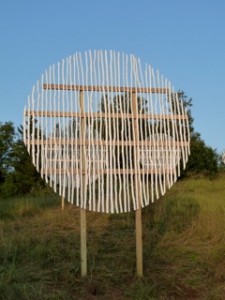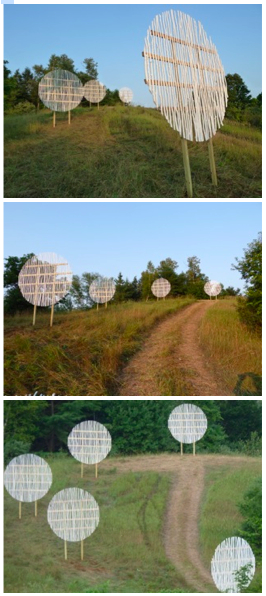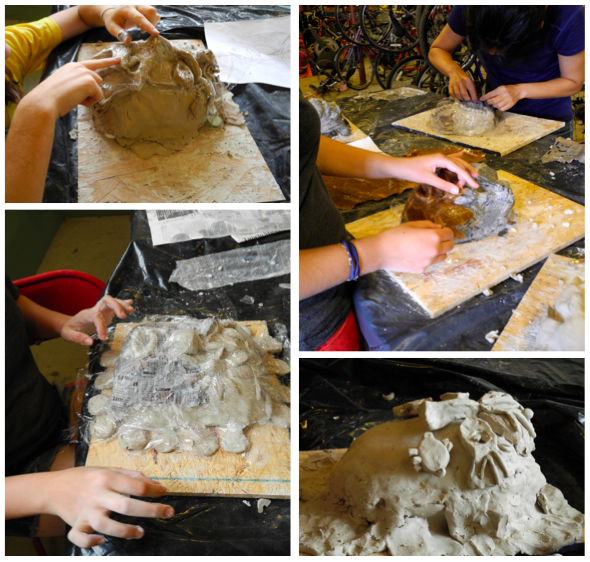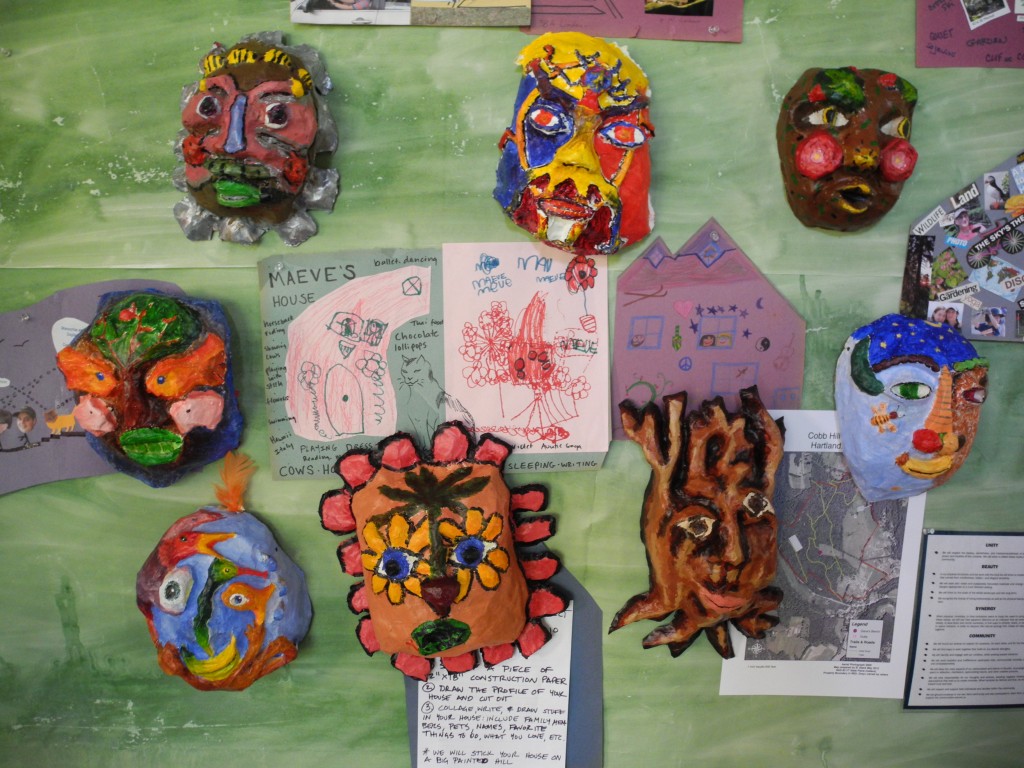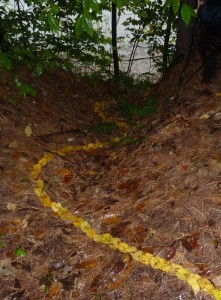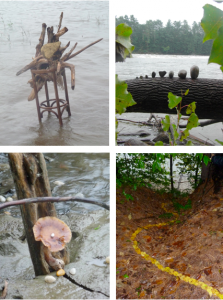This is my latest piece “When the Moon Came to Earth.” Each disc is made of saplings and measures 10′ in diameter. It’s installed at King Farm, which is an extension of Sculpture Fest.
Posts Tagged ‘nature’
When the Moon Came to Earth – Installed
Tuesday, August 21st, 2012Mask Making with Students from New York City
Friday, July 27th, 2012
I recently led a mask making workshop at Cobb Hill with students from the Brearley School in New York City. The second year of students to stay at Cobb Hill during the summer, they came to learn about rural living, sustainability, and organic farming. Their presence created a fun exchange of lifestyles and ideas.
In many cultures, putting on a mask signifies the creation of a new persona, and therefore a new set of understandings, empathies, and ways of thinking. The participants in the workshop created masks while learning about the significance of mask-making in different cultures. They used natural elements collected around Cobb Hill and integrated them with other materials to create their pieces of art.
Creative problem solving is essential for addressing the many challenges we face in bringing about a sustainable future for people and planet. In this workshop the next generation engaged in creative expression and expanded their problem-solving skills, while also using these as a tool for cross-cultural exchange.
I received this note after the workshop:
“Thank you so much for guiding us through mask-making: we loved every minute of it. It was amazing to see our nature elements combined with human features take shape as we molded, constructed and painted them with vibrant colors. You were extremely patient, and your critiques for every one of our masks was always so kind and your advice always so helpful.” – Participants from the Brearley School, New York City
The above photos were taken by Annie Byerly and Xiaofu Ding, and Cobb Hill resident Carla Kimball.
When the Moon Came to Earth – The Process
Monday, June 18th, 2012Friend and photographer, Carla Kimball, documented progress I made in creating When the Moon Came to Earth, a piece for Woodstock, Vermont’s Sculpture Fest. Click to see her first installment and second installment of photographs.
Systems Thinking through Art in Nature
Friday, April 13th, 2012By guest writer, Dominic Stucker, Program Manager at Sustainability Leaders Network. Based on participation in several of my art in nature workshops, Dominic offers these reflections.
Systems thinking and creativity are essential for bringing about the transition to sustainability. Systems thinking helps us assemble diverse stakeholders to better understand the integrated economic, social, and environmental systems we seek to change. Creativity and art help us gain clarity in vision and tap into the breakthrough thinking necessary for innovating a new reality, a new relationship between people and planet. Fortunately, these leadership skills are mutually reinforcing, especially through making art in nature.
Immersing ourselves in nature, sitting quietly, eyes opened, eyes closed, we can hone our skills of observation, noticing patterns and processes that have evolved over millennia. Using all our senses, we can experience and learn from nature. Perhaps we see the streams, brooks, and river in a basin, noticing nature’s nested hierarchies. Or we reflect on the larger water cycle, a process that, instead of linear and polluting, is cyclical and cleansing. Gazing skyward from a soft bed of pine needles, we can observe the forest’s resilience in flexibility, trees swaying in the wind. Or we smell the pungent soil, part of annual cycle that returns sustenance to the trees’ roots. Perhaps we see the genius in a flower, tracking the sun and folding its petals at dusk; or in the capacity of a cactus to store water; or in the design of a feather. We can learn from and co-create with these natural systems.
I have had the privilege and joy of participating in several Art of Sustainability sessions with Vermont artist and educator, Jay Mead. Two that stand out were along the Housatonic River in rural Connecticut and along a wild part of the Connecticut River in Vermont. Jay invites participants to see nature anew through quiet observation, sensing, and play. The invitation includes being fully present, setting aside transient to do lists and deep-seated preconceptions about how the world works. Participants are asked to start from a place of unknowing – playful for some, meditative for others – being open for deeper wisdom to emerge.
Art of Sustainability on the Connecticut River
Tuesday, November 1st, 2011As part of the annual Dana Meadows Fellows Seminar, organized by the Sustainability Leaders Network here at Cobb Hill Cohousing, Vermont from 3-7 October, I offered a session on the art of sustainability at Sumner Falls, a wild and wooded part of the Connecticut River.
The session focused on engaging the right brain, which is closely associated with thinking outside the box and creativity. Creative problem solving is essential for addressing the many challenges we face in bringing about a sustainable future for people and planet; art and creative expression is a powerful mechanism for enhancing this capability.
I asked the group to start from a place of unknowing, of having no preconceived notions. I then asked them to observe what they saw around them, reflect, see patterns, play, and create an art piece. The recent flooding of the river meant that flotsam and jetsam were incorporated into many pieces, bringing order and beauty to the chaos. Afterwards, we toured the art pieces to hear reflections inspired by the creative process. This process of creating something out of found materials provided another method of storytelling for participants so that insights on personal and work lives emerged and were shared.
Learn more about our Art of Sustainability efforts on the Sustainability Leaders Network website.

